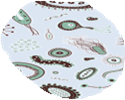Navigating this Part of the Pathway
This part of the pathway provides students with experiences that allow them to continue to piece together an answer to the overall driving question: Why are the fish dying in Sunrise Farm Pond? In particular, Part Two of the pathway introduces students to decomposers. Students begin by watching videos of decomposing fruits and vegetables and considering what caused them to rot. They set up their own experiments with decomposing foods in various conditions in order to determine what decomposers need (and to see that decomposers are consumers, not producers). Next, students learn about the various types of organisms that are decomposers. They also discuss the important role decomposers play in recycling nutrients in the ecosystem. Finally, the students revisit their cross-sectional pond model and make revisions using their emerging understanding about decomposers and the role they might play in Sunrise Farm Pond.
The food of almost any kind of animal can be traced back to plants. Organisms are related in food webs in which some animals eat plants for food and other animals eat the animals that eat plants. Some organisms, such as fungi and bacteria, break down dead organisms (both plants or plants parts and animals) and therefore operate as “decomposers.” Decomposition eventually restores (recycles) some materials back to the soil. Organisms can survive only in environments in which their particular needs are met. A healthy ecosystem is one in which multiple species of different types are each able to meet their needs in a relatively stable web of life. Newly introduced species can damage the balance of an ecosystem.
Matter cycles between the air and soil and among plants, animals, and microbes as these organisms live and die. Organisms obtain gases, and water, from the environment, and release waste matter (gas, liquid, or solid) back into the environment.
Connections to Other Pathway Parts
Part Two of the pathway builds on the ideas discussed in Part One and serves to connect the initial disturbance (i.e., fertilizer runoff) with depleted oxygen in the pond, in part due to decomposers using the oxygen as they consume dead algae. The three pathway parts together represent the natural sequence of events that occurs when a pond is overloaded with nutrients. Therefore, all pathway parts should be included in instruction and done in order.
Teacher Content Background
Decomposers, such as some bacteria, fungi, and earthworms, are consumers that break down dead organisms (or parts of organisms). Decomposition eventually recycles some materials back to the environment, making necessary resources available to producers.
The pond at Sunrise Farm, like all ponds, contains bacteria in addition to the algae and other organisms students learned about in Part 1. Many of the bacteria are microbial decomposers. These bacteria consume the dead material in the pond, including, in this case, the dead algae. The bacteria use oxygen in their process of consuming the algae, and because there are many dead algae to consume, a lot of the pond’s oxygen is used in this process.
Also in the process of decomposing algae, the bacteria release carbon dioxide and nutrients that can be used by the producers in the pond. The algae use these products to grow, which can also contribute to the increase in algae in the pond.
Student Thinking
Students are often unfamiliar with decomposers and decomposition. They tend to discount the important function that decomposers and decomposition play in an ecosystem, likely due to their unfamiliarity (Leach et al., 1992; Özkan et al., 2004). Some believe that decomposition is a process that occurs in the absence of decomposers (i.e., that material decomposes on its own) (Çetin, 2007; Ero-Tolliver, Lucas, & Schauble, 2013; Grotzer, 2009; Helldén, 1998; Hogan & Fisherkeller, 1996; Leach et al., 1992, 1995). Others who accept that decomposition involves decomposers see the decomposers as the end station of the process; that is, they tend to think that decomposed material becomes a part of the decomposer rather than being converted into resources to be used by the ecosystem (Hogan, 2000; Leach et al., 1996a).
Students also are uncertain about which organisms perform decomposition and often do not associate microbes with decomposition (Çetin, 2007; Grotzer, 2009; Grotzer, Basca, & Donis, 2011; Leach et al., 1992). Students often associate a negative connotation with the word “bacteria,” which may interfere with their ability to see microbes as beneficial (Spring and Harr, 2014).
Finally, students frequently have an aversion to decomposition because they think it is “gross” or “yucky.”
Student Experiences
Student Experience 1: What happened to the fruit and vegetables? (Students observe and discuss a time-lapse video of fruit over 74 days.) 5.LS2.A CCC: Cause and Effect
Student Experience 2: What are decomposers? (Students will consider whether decomposers are producers or consumers and set up an experiment to observe decomposition.) 5.LS2.A SEP: Planning and Carrying Out Investigations SEP: Analyzing and Interpreting Data CCC: Patterns
Student Experience 3: What are decomposers? (Continued) (Students discover the types of organisms that are decomposers.) 5.LS2.A
Student Experience 4: What do decomposers do? (Students consider the role decomposers play in the ecosystem.) 5.LS2.A SEP: Constructing Explanations
Student Experience 5: How should we revise our pond model? (Students revisit the mystery at the Sunrise Farm Pond and revise their models based on new ideas.) 5.LS2.A 5.LS2.B SEP: Developing and Using Models SEP: Constructing Explanations CCC: Cause and Effect
Student Experience 6: More of the story (Students hear more of the story from the Mystery at Sunrise Farm Pond and discuss how it relates to their pond models.) 5.LS2.A SEP: Developing and Using Models SEP: Asking Questions CCC: Cause and Effect CCC: Stability and Change CCC: Systems and Systems Models
